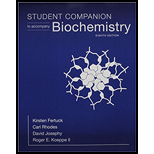
Concept explainers
Interpretation:
Difference between the de novo synthesis and salvage-pathway synthesis of
Concept introduction:
Purines and pyrimidines are the nucleotides, which are produced in the liver. They contain a molecule of sugar and phosphate. The location of nitrogen in both the nucleotides is different. Their pathways of synthesis are different, but they need a common phosphorylated 5-carbon monosaccharide.
Answer to Problem 1P
De novo pathway includes the simpler substrates that are used to synthesize pyrimidines.
Salvage pathways include the preformed and recovered bases for the synthesis of purines.
Explanation of Solution
The difference between the de novo pathway and the salvage pathway is given as below:
| De novo pathways | Salvage pathways |
| 1. Simple substrates are used in the de novo pathways for the synthesis of nucleotides. | 1. In the salvage pathways, bases are recovered, preformed, and reconnected to the ribose sugar. |
| 2. It is used to synthesize all the pyrimidines. Only two precursors, aspartate, and carbamoyl phosphate, are required here. | 2. It is used to synthesize the purines. Many substrates are required here for the synthesis of purines. |
De novo pathway includes the simpler substrates that are used to synthesize pyrimidines.
Salvage pathways include the preformed and recovered bases for the synthesis of purines.
Want to see more full solutions like this?
Chapter 25 Solutions
Student Companion for Biochemistry
- Molecular detail of spike Y453Farrow_forwardUsing the biosynthesis of aminolevulinate (ALA) as an example, describe at least two techniques that can be used to elucidate detail of a biosynthetic pathway. Please keep brief - 5 sentences/dot points max.arrow_forwardBiotransformation. Explain the process of enzyme induction. What are the benefits or down-falls of this process.arrow_forward
- Question:- Based on the figure below, predict what peptide bond could be the substrate of each protease(The bond marked in blue is where hydrolysis occurs, choose 2 peptides per protease type) Chymotrypsin:_________ Trypsin:_________ Elastase:_________ 1. SR−SG 2. SF−SG 3. SK−SG 4. SA−SG 5. SV−SG 6. SM−SGarrow_forwardAmino Acid Degradation Pathway (some choices can be selected more than once)arrow_forwardBIOMOLECULES - Please answer the questions properly. - Multiple choice 1. Analyze the following and identify which one mentions the function of a common eukaryotic ligase? A. Convert pyruvate into acetyl-coenzyme A B. Transfer amino groups from an amino acid to an alpha-keto acid C. Join lagging strands (Okazaki fragments) of DNA during replication D. Catalyze the conversion of glucose-6-phosphate into fructose-6-phosphate 1. The coenzyme biocytin is associated with which of the following vitamins? A. nicotinic acid B. pyridoxine C. thiamine D. biotinarrow_forward
- BIOMOLECULES - MULTIPLE CHOICE - Please answer properly QUESTION : In human beings, what is the major control of de novo pyrimidine nucleotide synthesis? A. substrate availability B. competitive inhibition of carbamoyl phosphate synthetase II C. feedback inhibition of glutamine-PRPP amidotransferase D. vailability of N-acetyl glutamatearrow_forward14. DNA polymerase uses which of the following catalytic strategies: Group of answer choices Metal ion catalysis Hydrophobic catalysis Covalent catalysis General base catalysisarrow_forwardIllustrating the importance of triphosphate and monophosphate molecules, explain the process of RNA biosynthesis by RNA polymerase.arrow_forward
- Explain the synthesis process of Losartan? Please answer at your own words.arrow_forwardTranslation in eukaryotes and prokaryotes are similar and yet different. From a therapeutic perspective, why is this advantageous?arrow_forwardMutation identity- GLY Outline the effects the mutation will have on the 3D structure and function of the 3GRS glucathione reducatse protein.arrow_forward
 BiochemistryBiochemistryISBN:9781319114671Author:Lubert Stryer, Jeremy M. Berg, John L. Tymoczko, Gregory J. Gatto Jr.Publisher:W. H. Freeman
BiochemistryBiochemistryISBN:9781319114671Author:Lubert Stryer, Jeremy M. Berg, John L. Tymoczko, Gregory J. Gatto Jr.Publisher:W. H. Freeman Lehninger Principles of BiochemistryBiochemistryISBN:9781464126116Author:David L. Nelson, Michael M. CoxPublisher:W. H. Freeman
Lehninger Principles of BiochemistryBiochemistryISBN:9781464126116Author:David L. Nelson, Michael M. CoxPublisher:W. H. Freeman Fundamentals of Biochemistry: Life at the Molecul...BiochemistryISBN:9781118918401Author:Donald Voet, Judith G. Voet, Charlotte W. PrattPublisher:WILEY
Fundamentals of Biochemistry: Life at the Molecul...BiochemistryISBN:9781118918401Author:Donald Voet, Judith G. Voet, Charlotte W. PrattPublisher:WILEY BiochemistryBiochemistryISBN:9781305961135Author:Mary K. Campbell, Shawn O. Farrell, Owen M. McDougalPublisher:Cengage Learning
BiochemistryBiochemistryISBN:9781305961135Author:Mary K. Campbell, Shawn O. Farrell, Owen M. McDougalPublisher:Cengage Learning BiochemistryBiochemistryISBN:9781305577206Author:Reginald H. Garrett, Charles M. GrishamPublisher:Cengage Learning
BiochemistryBiochemistryISBN:9781305577206Author:Reginald H. Garrett, Charles M. GrishamPublisher:Cengage Learning Fundamentals of General, Organic, and Biological ...BiochemistryISBN:9780134015187Author:John E. McMurry, David S. Ballantine, Carl A. Hoeger, Virginia E. PetersonPublisher:PEARSON
Fundamentals of General, Organic, and Biological ...BiochemistryISBN:9780134015187Author:John E. McMurry, David S. Ballantine, Carl A. Hoeger, Virginia E. PetersonPublisher:PEARSON





